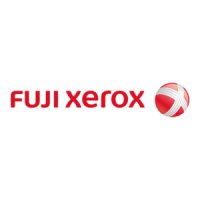
Do you have a question about the Fuji Xerox ApeosPort-IV 3070 and is the answer not in the manual?
| Brand | Fuji Xerox |
|---|---|
| Model | ApeosPort-IV 3070 |
| Category | Copier |
| Language | English |
Introduction to the user guide, its purpose, and target audience.
Lists and describes the various manuals provided with the machine.
Explains the guide's structure and conventions used for clarity.
Provides crucial safety instructions, warnings, and symbols for safe machine operation.
Contains information on radio frequency emissions and product safety certifications.
Details environmental considerations for product use, recycling, and disposal.
Outlines software licenses, copyrights, and terms for included components.
Informs about legal restrictions on copying and printing certain documents.
Details and illustrates the various components of the machine and their functions.
Explains the power switch and main power switch operations.
Describes the ground fault interrupter and how to check its functionality.
Explains the Low Power and Sleep modes for reducing power consumption.
Details the names and functions of all buttons and displays on the control panel.
Describes the fields and buttons available on the main [Services Home] screen.
Provides instructions for entering text using the on-screen keyboard.
Step-by-step instructions for installing the tray attachment on Finisher-B1.
Details the basic steps for loading documents and selecting copy features.
Explains how to stop, change quantity, or interrupt a copy job during operation.
Allows selection of basic copy features for easy document copying.
Enables detailed copy settings like reduce/enlarge, paper supply, and output format.
Covers adjustments for original type, density, sharpness, and background suppression.
Provides options for adjusting layout, including 2-sided copying and edge erase.
Covers features like booklet creation, pages per side, and cover attachment.
Allows processing multiple documents with different settings as a single job.
Details the basic procedures for sending faxes, including loading documents and specifying destinations.
Describes how to stop a fax job and change scan settings during transmission.
Explains Internet Fax features, sending, receiving, and associated restrictions.
Describes IP Fax (SIP) features, connection configurations, and network requirements.
Explains how to use the Server Fax service for transferring image data via network.
Allows selection of basic features for easily sending faxes.
Covers features for sending faxes and Internet faxes, including destinations and settings.
Provides options for adjusting fax layout, such as 2-sided scanning and original size.
Details options like acknowledgement reports, starting rate, and priority send.
Covers features such as remote polling, store for polling, and on-hook operations.
Explains broadcast send and relay broadcast for transmitting documents to multiple recipients.
Describes auto and manual receive modes, and folder receive.
Provides information on subscriptions and advanced operating procedures for facsimile services.
Details the basic scanning procedure, including loading documents and selecting features.
Describes how to stop a scan job or change scan settings during scanning.
Scans documents and sends them as e-mail attachments in various file formats.
Allows scanning documents using job templates for forwarding to a server.
Scans documents and sends data to a network computer via FTP or SMB protocol.
Scans documents and saves the scanned data in a folder on the machine.
Allows scanning documents and saving the data to a USB memory device.
Temporarily saves scanned data and sends URLs via e-mail for retrieval or deletion.
Scans documents and saves data to a network computer or computer on the network.
Covers features like photographs, image options, and color space settings.
Provides options for adjusting scan layout, including resolution and original size.
Details options for e-mail and filing, such as quality, read receipts, and file names.
Describes the basic procedures for operating files stored in folders.
Explains how to select a folder for accessing stored files.
Covers checking, selecting, and operating files stored within a folder.
Allows previewing selected files to check their contents.
Provides instructions for printing files stored in a folder.
Describes how to register transfer settings for scanned data to simplify tasks.
Details the procedure for operating a job flow, including opening screens and starting the flow.
Explains how to select or edit job flow sheets created on a network computer.
Introduces the service for storing and calling customized job settings.
Covers procedures for registering, deleting, and renaming stored programs.
Explains how to call a stored program to execute predefined settings.
Describes the service for accessing web applications via a network.
Details how to access web applications by registering access destinations.
Explains how to access web applications by selecting registered buttons on the Services Home screen.
Introduces the Media Print feature for retrieving and printing document files from USB.
Provides instructions for inserting a USB memory device into the machine.
Explains methods for selecting files for printing from a USB device.
Details options for setting print parameters for Media Print.
Provides an overview of checking current, pending, and completed jobs.
Describes how to check and manage current or pending jobs.
Explains how to check completed jobs and view their details.
Covers printing or deleting jobs stored via Secure Print, Sample Set, or Charge Print.
Describes how to forcibly print jobs waiting for auto print or resume paused jobs.
Provides guidance on handling error terminations for print, fax, and scan jobs.
Provides an overview of features performable from a computer, including print, e-mail, and fax.
Describes how to print documents from a computer using the machine.
Explains how to send documents via e-mail for automatic printing by the machine.
Describes how to send faxes directly from a computer using the Direct Fax feature.
Details methods for importing files stored in a machine's folder to a computer.
Explains how to view machine status, change settings, and import files via a web browser.
Contains a glossary of terms used throughout the user guide.